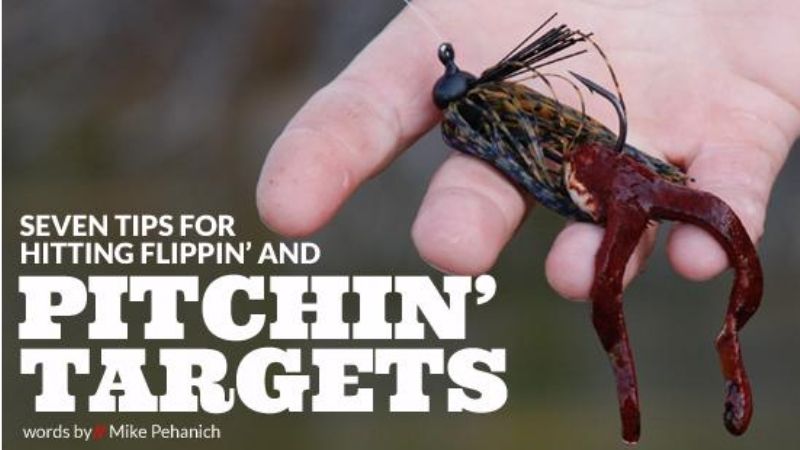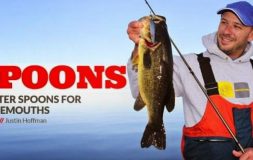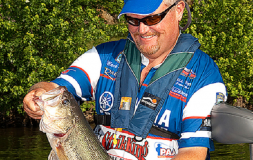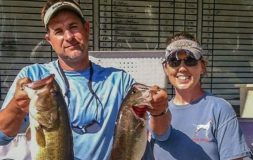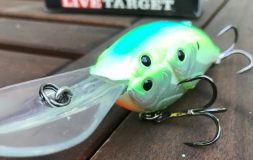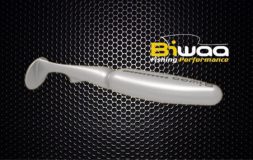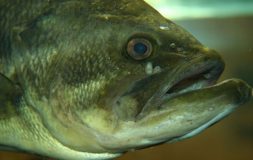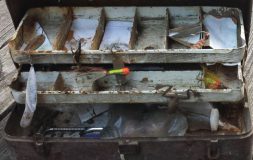Seven tips for hittin, flippin’ and pitchin’
Jared Lintner teams the right tools with knowledge, practice and jig/trailer combinations to coax big bass from docks and heavy cover. Follow his seven guidelines to flipping and pitching success!
Jared Lintner knows a thing or two about both big bass and flipping/pitching technique. His home waters of Clear Lake and the California Delta are fabled big bass waters where he has honed his skills to become one of the most effective practitioners of flipping and pitching technique on the Bassmaster Elite Series tour.
Lintner’s bread-and-butter bait for this “tight quarters” casting is the venerable “jig-and-pig” combination. Lintner is a firm believer in the value of a jig trailer made from real pork, which he believes presents a more lifelike offering and realistic mouthfeel to the fish than a plastic trailer.
The arrival of the Uncle Josh MEAT line of jig trailers, which are made entirely from pork fat (no skin) and are packaged in resealable plastic bags, has added to both the performance and convenience of these trailers. Lintner himself influenced the creation of the MEAT Craw and TW CrawFrog and the MEAT TW Bubba. The latter two products are sold exclusively through Tackle Warehouse.
Lintner offers these seven tips to get deadly effective with the jig and pig.
Tip #1: Enter the darkness – Docks, sunken boathouses, fallen trees…Such cover casts discernible shadows that beg your attention. “The far corner of that boathouse where the water is really dark…that is going to be your money cast!” says Lintner. “Put your bait anywhere there’s a transition from light to dark. Bass don’t want to sit where they can be seen. They want to sit in ambush. Always remember ‘the deepest, darkest spot’ when you are flipping and pitching a jig!”
Tip #2: Let it fall! – The cardinal sin of errant flippers is failure to follow up an accurate cast with a vertical fall. “A lot of guys engage the reel and start working the bait the second it hits the water. Don’t do that!” warns Lintner. “Let the lure fall on a slack line, and a lot of times you will get a reaction bite as bass grab it on the fall. But if you tighten that line immediately, the bait starts coming to you right away. That’s not natural.” And you will miss the fish!
Tip #3: Use tools of the trade – Gear up with rod, reel and line that will allow you to present your baits properly and pull fish out of heavy cover. Lintner’s tools are the G. Loomis 894 FPRGLX flipping rod with a Shimano Chronarch E7. “I like a 7:1 gear ratio because a lot of time that fish is hot and moving, and you have to catch up to him quickly!” His line choices are Sunline FX braid and 25-pound test Sunline Shooter fluorocarbon.
Tip #4: Work Outside in – Don’t miss the easy pickings! Pick apart the outside edges of docks, brush and tree limbs before pitching to the ambush points deep within the cover.
Tip #5: Dare to get in there – Pitching to heavy cover is no game for the timid! Many anglers avoid the nasty cover where big bass lie in ambush. Big mistake! “That cast on the front edge of the dock is doing nothing. But skip that bait under the dock, and now you are in her house!” says Lintner. “You have increased your odds of getting a big bass by more than one-half by getting that bait two feet under the dock rather than just dropping it on the edge.”
Tip #6: Corner them! – Dock corners, cross beams, the intersection of a boat’s stern with a dock face…corners create multiple shadows and outstanding ambush points. Complex dock layouts create more prime locations as well. Look for ladders, too.
Tip #7: Practice – Growing up, Lintner emulated masters of flipping and pitching technique like Denny Brauer and Tommy Biffle. He copied their practice habits, too, setting up coffee cans in his parents’ backyard and flipping and pitching to these tough targets daily. “You can’t just get the right rod and reel and right pork trailer and think you are going to drop your bait on a dime,” says Lintner. “Practice is everything!”


